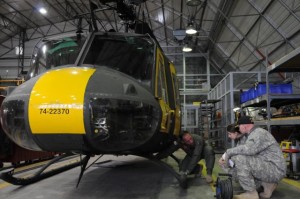The end of an era: Hohenfels trains last Huey pilots
April 15, 2009 by Da-Chief
Filed under Air Force News, Army News, Corpsman.com News, Marine Corps News, National Guard News, Navy News

Left to right: Chief Warrant Officer 4 Michael Chickilly, UH-1 standardization pilot and maintenance examiner, walks Maj. Heidi Ridenhour-Jones and Capt. Sam Redding through their pre-flight evaluation March 25 in preparation for their check ride on a UH-1 Huey helicopter. Ridenhour-Jones and Redding are two of the last four pilots the Joint Multinational Readiness Center will train to operate the aircraft that will be completely retired from the Army by 2012 after a 50-year career as the Army's workhorse, used most extensively and famously in Vietnam.
HOHENFELS, Germany — Four Army aviators training at the Joint Multinational Readiness Center in Hohenfels, Germany, this March marked the beginning of the end for an aircraft that has been one of the most recognizable faces of Army aviation for half a century.
The new observer/controllers with the JMRC ‘Falcon’ team are the last pilots at Hohenfels, and among the last Army-wide, that will train to fly the UH-1 Huey helicopter, an aircraft used most notably in the Vietnam War and made famous in movies such as ‘We Were Soldiers.’
“It’s kind of the end of an era,” said Chief Warrant Officer 4 Ben Maupin, a Falcon and one of five remaining Huey standardization instructor pilots.
According to Maupin, there are only approximately 60 Hueys still used in the active Army and 70 in the Army National Guard, none of which are used in combat.
Hohenfels plans to retire its fleet in April 2010 when UH-72 Lakotas will replace their ten Hueys that were built in the 1970’s.
By this September the National Guard will turn in their remaining Hueys and by October 2012 all Hueys throughout the Army will be retired, most of which will be sent to foreign military sales in Temple, Texas, according to Chief Warrant Officer 4 Sean Higgins, UH-1 and UH-72 branch chief and director of evaluation and standards for the United States Army Aviation Center at Fort Rucker, Ala.
Capt. Sam Redding, one of the four pilots training at Hohenfels, said he is lucky to be one of the last pilots to fly an aircraft with such a rich history.
“There were some helicopters before (the UH-1), but the Huey is the workhorse. The technology that has been used in Iraq and Afghanistan was developed on the Huey. It is a multipurpose airframe that has gotten us to where we are now. It’s a pride thing,” he said.
Maj. Heidi Ridenhour-Jones, who, like Redding trained on Blackhawks in flight school, said piloting the Huey is a great opportunity.
“People are not going to be flying these anymore. There is a lot of aviation history that revolves around the Hueys, but I thought it would be an airframe I just never got to fly. This is a great opportunity to get to fly an aircraft most people won’t be able to say that they have flown.”
Though these aviators are proud to be part of a significant chapter in military history, Redding said the training is not just nostalgia, it is necessity.
Pilots with the Falcon team must be able to operate the Hueys to fulfill their mission as an observer/controller.
According to Maupin, they are used to observe aviation units that come to JMRC to train, as well as to help other training units practice using helicopters in combat for tasks such as extracting injured Soldiers from the battlefield.
He said because its newer counterparts-Blackhawks and Apaches-are needed in Iraq and Afghanistan the Hueys are serving a few more years until retirement than expected.
Lt. Col. James Barker, Falcon commander, said though they are now used solely for training, Heuys were once an important link between Army aviators and the Soldiers on the ground, especially in Vietnam.
“The ground forces in Vietnam truly considered the Hueys and the pilots their guardians. Since then as Army aviation has evolved we have grown further away with the relationship we had with the ground Soldiers, until Iraq and Afghanistan when Army aviators, especially our helicopter fleet, has regained the trust of our ground brothers,” he said, telling a story about a Soldier wounded in Iraq who, upon seeing the medical evacuation helicopter pilot said, “I knew you would come.”
“Having experienced that relationship on deployment, to come back here and fly the Huey, that is the granddaddy of the helicopters now, is really a rare and special opportunity.”








The Huey is the DC-3 of helicopter aviation.It will be around in both military and civilian aviation for years to come. The fact that it is being phased out of the U.S. military is unfortunate in some ways but this helicopter will out live us all.
I totally Agree, there is nothing like having your ass strapped into a safety harness and sitting with your feet hanging out of one of these.. Awesome.. 😉
What a workhorse.. Did everything asked of it.